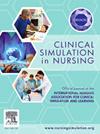A telenursing simulation to assess nursing students’ readiness for practice in screening adolescents for depression
IF 2.5
3区 医学
Q1 NURSING
引用次数: 0
Abstract
Mental health diagnoses have become prevalent among pediatric patients, leading to the enhanced need for undergraduate nursing students to be competent and comfortable screening and caring for these individuals. Using video-conferencing software as a simulated, telenursing, virtual platform, nursing learners engaged in a simulated scenario with a standardized patient (SP) acting as an adolescent experiencing clinically significant depressive and anxiety symptoms. This simulation was implemented to improve the knowledge, skills, and attitudes of learners in identifying and caring for adolescents experiencing these symptoms. Learners reported a perceived increase in knowledge (M = 3.45 out of 5, SD = 0.93) and self-reported a significant increase in confidence to care for patients reporting depressive symptoms postsimulation (M = 3.49, SD = 0.50) to postsimulation (M = 3.67, SD = 0.52; t (196)= -5.14, p < .001, d = -0.37). Telenursing simulation in undergraduate nursing education introduces nursing students to the principles of telenursing best practices while aligning the nursing curriculum with the American Association of Colleges of Nursing’s Essentials and enhancing practice readiness for the future nursing workforce.
远程护理模拟评估护理学生准备实践筛选青少年抑郁症
心理健康诊断在儿科患者中变得普遍,导致对本科护理学生有能力和舒适的筛查和照顾这些个体的需求增加。使用视频会议软件作为模拟的远程护理虚拟平台,护理学习者与标准化患者(SP)一起参与模拟场景,扮演患有临床显著抑郁和焦虑症状的青少年。实施该模拟是为了提高学习者在识别和照顾经历这些症状的青少年方面的知识、技能和态度。学习者报告了感知到的知识增加(M = 3.45 / 5, SD = 0.93),自我报告在模拟后(M = 3.49, SD = 0.50)对模拟后(M = 3.67, SD = 0.52; t (196)= -5.14, p < 001, d = -0.37)照顾报告抑郁症状的患者的信心显著增加。本科护理教育中的远程护理模拟向护理学生介绍了远程护理最佳实践的原则,同时使护理课程与美国护理学院协会的要点保持一致,并为未来的护理人员做好实践准备。
本文章由计算机程序翻译,如有差异,请以英文原文为准。
求助全文
约1分钟内获得全文
求助全文
来源期刊

Clinical Simulation in Nursing
NURSING-
CiteScore
5.50
自引率
15.40%
发文量
107
期刊介绍:
Clinical Simulation in Nursing is an international, peer reviewed journal published online monthly. Clinical Simulation in Nursing is the official journal of the International Nursing Association for Clinical Simulation & Learning (INACSL) and reflects its mission to advance the science of healthcare simulation.
We will review and accept articles from other health provider disciplines, if they are determined to be of interest to our readership. The journal accepts manuscripts meeting one or more of the following criteria:
Research articles and literature reviews (e.g. systematic, scoping, umbrella, integrative, etc.) about simulation
Innovative teaching/learning strategies using simulation
Articles updating guidelines, regulations, and legislative policies that impact simulation
Leadership for simulation
Simulation operations
Clinical and academic uses of simulation.
 求助内容:
求助内容: 应助结果提醒方式:
应助结果提醒方式:


